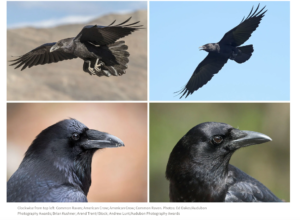We are used to seeing crows locally – they are intelligent and adaptable birds which have prospered in the landscape we’ve forged. They’re at home in farmland and city, living alongside people but at the same time keeping their distance. They aren’t the only birds in the family Corvidae, which also includes in our neck of the woods, ravens and jays. Jays, too, have developed the ability to cohabit the landscape of people as long as there’s a patch of woods nearby. But around here, ravens are a special treat. We might not notice them at first sight- if you don’t look closely you might not distinguish them from crows. But ravens are larger and are found usually singly or in pairs.
 Mostly, ravens are found in northern Wisconsin, nesting on rocky cliffs or in tall pine trees. Their rough, croaking call is much different from the caws of American crows, and hearing them reminds me of my favorite times in places like the Boundary Waters or the UP of Michigan. They are significantly larger than crows, although if the two are not seen together it’s not always obvious. The ends of both their bodies give them away, however. Their beaks are massive, much larger and heavier than a crow’s and their tails are diamond-shaped at the trailing end, unlike the square tails of crows.
Mostly, ravens are found in northern Wisconsin, nesting on rocky cliffs or in tall pine trees. Their rough, croaking call is much different from the caws of American crows, and hearing them reminds me of my favorite times in places like the Boundary Waters or the UP of Michigan. They are significantly larger than crows, although if the two are not seen together it’s not always obvious. The ends of both their bodies give them away, however. Their beaks are massive, much larger and heavier than a crow’s and their tails are diamond-shaped at the trailing end, unlike the square tails of crows. Despite the general similarity in appearance- large, all-black birds- the two species do not get along well with each other. Both are very intelligent, and are measurably among the smartest of animals. Researchers are constantly coming up with new ways to test this with very interesting results. Recently I read that ravens were able to recognize certain patterns in lines of written characters, something few animals aside from people can do. There are many accounts of the interesting behaviors of both crows and ravens, such as bringing gifts in return for being fed. But, they can use those abilities for mischief as well, sometimes to harass other animals and even each other.
Their intelligence also gives rise to our suspicions about ravens. In places where they have become used to people, they are often thieves, stealing food and other items which catch their fancy. Their blackness prevents us from discerning any expression, and it’s hard to know what they are thinking or to predict what they will do. They are highly regarded by Native people as both spirits and tricksters, deservedly so. As ravens are found almost all across the world, from here across Europe, Asia, even Siberia and over to Alaska, there are many stories from many cultures about them. People who have observed nature recognize their intelligence, and they often have high status. For example, in some stories ravens created the world. In others, they advised leaders like the Norse god Odin, who had two ravens, Huginn and Muninn (thought and memory). Being such interesting birds, there must be countless stories.
Recently some of our staff were driving and spotted a raven in a location they’ve been seen before, near a silo in a field near a wetland. One raven flew from the silo to a small woodlot, but was immediately spotted by two crows which flew to and began to harass their larger cousin. Another raven flew out from the silo, circled around and flew back, to be joined there by the first one. As we have no cliffs around here, we wonder if the silo is close enough to serve as a nesting place. It is no longer used for agricultural storage, and has been used for nesting by pigeons and starlings. But perhaps it is enough like a high, steep cliff to entice the raven pair to make it their home. Much to the disappointment of the pigeons and others (perhaps to their peril). We’ll continue to watch the site, hoping to see the pair during courtship (which can be quite an aerial display), nest building, and rearing of young. We’ve found ravens at Woodland Dunes almost every year, but have never documented a nesting. They have been known to nest in silos in other locations, and it seems logical that they would do so.
We see them nearly every year at Woodland Dunes, and consider ourselves lucky to do so. And I’m certain at the same time they are observing us, watching and wondering what we are up to.
Image- Raven vs. Crow, Audubon Photography awards
